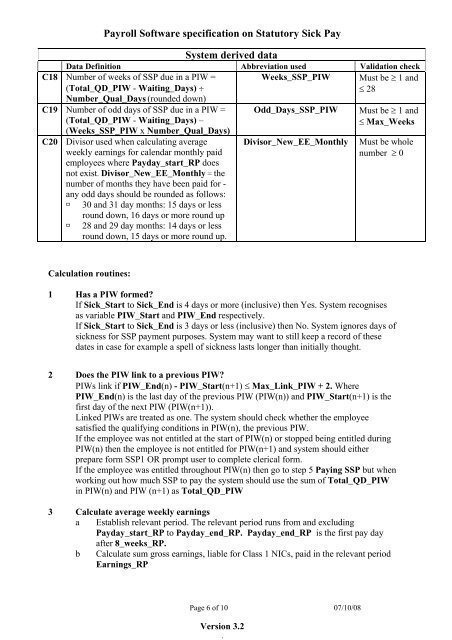Payroll Software specification on Statutory Sick Pay - HM Revenue ...
Payroll Software specification on Statutory Sick Pay - HM Revenue ...
Payroll Software specification on Statutory Sick Pay - HM Revenue ...
You also want an ePaper? Increase the reach of your titles
YUMPU automatically turns print PDFs into web optimized ePapers that Google loves.
<str<strong>on</strong>g><strong>Pay</strong>roll</str<strong>on</strong>g> <str<strong>on</strong>g>Software</str<strong>on</strong>g> <str<strong>on</strong>g>specificati<strong>on</strong></str<strong>on</strong>g> <strong>on</strong> <strong>Statutory</strong> <strong>Sick</strong> <strong>Pay</strong><br />
System derived data<br />
Data Definiti<strong>on</strong> Abbreviati<strong>on</strong> used Validati<strong>on</strong> check<br />
C18 Number of weeks of SSP due in a PIW =<br />
(Total_QD_PIW - Waiting_Days) ÷<br />
Number_Qual_Days (rounded down)<br />
C19 Number of odd days of SSP due in a PIW =<br />
(Total_QD_PIW - Waiting_Days) –<br />
(Weeks_SSP_PIW x Number_Qual_Days)<br />
C20 Divisor used when calculating average<br />
weekly earnings for calendar m<strong>on</strong>thly paid<br />
employees where <strong>Pay</strong>day_start_RP does<br />
not exist. Divisor_New_EE_M<strong>on</strong>thly = the<br />
number of m<strong>on</strong>ths they have been paid for -<br />
any odd days should be rounded as follows:<br />
30 and 31 day m<strong>on</strong>ths: 15 days or less<br />
round down, 16 days or more round up<br />
28 and 29 day m<strong>on</strong>ths: 14 days or less<br />
round down, 15 days or more round up.<br />
Calculati<strong>on</strong> routines:<br />
Weeks_SSP_PIW Must be ≥ 1 and<br />
≤ 28<br />
Odd_Days_SSP_PIW Must be ≥ 1 and<br />
≤ Max_Weeks<br />
Divisor_New_EE_M<strong>on</strong>thly Must be whole<br />
number ≥ 0<br />
1 Has a PIW formed?<br />
If <strong>Sick</strong>_Start to <strong>Sick</strong>_End is 4 days or more (inclusive) then Yes. System recognises<br />
as variable PIW_Start and PIW_End respectively.<br />
If <strong>Sick</strong>_Start to <strong>Sick</strong>_End is 3 days or less (inclusive) then No. System ignores days of<br />
sickness for SSP payment purposes. System may want to still keep a record of these<br />
dates in case for example a spell of sickness lasts l<strong>on</strong>ger than initially thought.<br />
2 Does the PIW link to a previous PIW?<br />
PIWs link if PIW_End(n) - PIW_Start(n+1) ≤ Max_Link_PIW + 2. Where<br />
PIW_End(n) is the last day of the previous PIW (PIW(n)) and PIW_Start(n+1) is the<br />
first day of the next PIW (PIW(n+1)).<br />
Linked PIWs are treated as <strong>on</strong>e. The system should check whether the employee<br />
satisfied the qualifying c<strong>on</strong>diti<strong>on</strong>s in PIW(n), the previous PIW.<br />
If the employee was not entitled at the start of PIW(n) or stopped being entitled during<br />
PIW(n) then the employee is not entitled for PIW(n+1) and system should either<br />
prepare form SSP1 OR prompt user to complete clerical form.<br />
If the employee was entitled throughout PIW(n) then go to step 5 <strong>Pay</strong>ing SSP but when<br />
working out how much SSP to pay the system should use the sum of Total_QD_PIW<br />
in PIW(n) and PIW (n+1) as Total_QD_PIW<br />
3 Calculate average weekly earnings<br />
a Establish relevant period. The relevant period runs from and excluding<br />
<strong>Pay</strong>day_start_RP to <strong>Pay</strong>day_end_RP. <strong>Pay</strong>day_end_RP is the first pay day<br />
after 8_weeks_RP.<br />
b Calculate sum gross earnings, liable for Class 1 NICs, paid in the relevant period<br />
Earnings_RP<br />
Page 6 of 10 07/10/08<br />
Versi<strong>on</strong> 3.2<br />
.

















